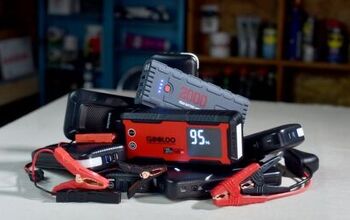Hankook Winter i*cept iZ3 Review: Reclaiming Cold Weather Confidence

Long-Term Testing of Hankook's Newest Winter Tire
Note: It’s never too early to think about winter tires. So with that in mind, save yourself some hassle in a few months time, read this now, and thank me later!
I didn’t plan on needing winter tires. In fact, a part of me thought I might never use them again.
You see, recently I tested out some four season tires (different brands) on both my car and my wife’s car and I came away seriously impressed—at least at first.
Grip in the snow seemed almost indistinguishable from a true winter tire, and with all the other advantages, I thought my days of tire swapping were over. Not so.
Hankook had shipped me a set of their Winter i*cept iZ3 X tires to test, and I wasn’t in any rush to get them on my wife’s Honda Pilot. I had almost nothing but praise for four-season tires. For the first full year of testing, they proved tremendously impressive. But as we moved into year three of ownership, it was clear the grip level in inclement weather was decreasing at a much faster rate than the actual tread wear.
So while the tires certainly still had life in them for most seasons, they had become more like conventional all-season tires when the mercury dropped and the snow began to fall.
See Also: Can I Use Winter Tires All Year?
Following the “happy wife, happy life” mantra, I decided it was time to opt for something new, but figured that with winter almost over, this was a problem I could push into next Fall.
A nail left on the road from a new condo project had me adjusting my plans—and to my good fortune, that Hankook had shipped me the tires literally the day before.
With four-season tires on both of my cars, it’s been a few years since I did a tire swap, and inflation was a bit of a shock. For the winters, I needed new steel wheels, tire pressure sensors, and the price of mounting. All in, I was particularly happy to not have to pay for the tires themselves in this process, as it was expensive enough.
All the more reason, I think, to make sure when you spend this kind of money on tires, that you’re doing it right—and as infrequently as is possible/safe.
Hankook Winter i*cept iZ3
The Facts
There might be more technology in a modern set of tires than in a modern car. The engineering that goes into these rubber circles is amazing. In fact, there’s either almost no rubber in them or none at all.
Made of a next-generation compound, Hankook has made considerable improvements on this tire over its predecessor. This compound, combined with a selection of features and a unique tread pattern, offers big improvements on the road where it matters. Visually, the tires look unique, although there’s an increasing number of tires following this V-shaped tread pattern, as it has unique advantages.
In particular, the V shape offers larger exterior treadblocks for added stability. This same shape also allows for wider evacuation channels between the tread blocks, which means it can better push out water or, critically for a winter tire, slush.
With heavy siping (those zig-zag shapes) across the tread blocks, this tire has plenty of ability to grip snow-covered roads.
One truly noteworthy feature of this tire is the ice-grip slits that run in a different direction than the sipes. These little features allow for even better grip on icy surfaces.
See Also: Winter Tires vs All-Season Tires
I’m no stranger to winter tires, having tested loads of them over the years, and one thing that is often not mentioned is the difference in grip on ice versus snow for certain options. Some tires grip better in the former, and some the latter. What I’ve learned from my four-season tire experiment is that while four-season tires are good in winter (including snow), they are generally not recommended for driving on ice. And having had the chance to experience that this year I discovered it the hard way—it made me doubt everything I thought about four-season tires.
The Winter i*cept iZ3 makes use of 3D sipes, meaning that its advantages are more than just skin deep. On the surface, the sipes function like conventional winter tires, gripping the snow to the tread and using it to generate more grip overall. Under the surface is where the magic happens; however, with the 3D sipes locking together under braking to reduce tread flex and make for better braking performance, particularly on dry, cold surfaces.
As a result of this, Hankook promises a 9% improvement in braking distances on ice as well as 11% better acceleration on ice. Overall, the company says handling is improved by 19%. And wet weather braking is improved 5%.
The wider V-shaped tread pattern also has the unique advantage of making sure there’s more tread touching the ground at any given time. Not only does this make for more grip, but it means the car’s weight is distributed across a wider area, resulting in 30% more tread life than a conventional winter tire.
As a result, Hankook has the confidence to offer a 50,000-mile (80,000 km) tread life warranty on these tires. That might not sound like a lot, but many winter tires come with no tread life warranty at all. (Of note, the term tread life warranty is a bit of a misnomer as it’s not a guarantee, but rather an estimate by the manufacturer of how long they anticipate the tires to last under normal use).
For a final note on the specs side of this tire, Hankook offers it in 16- to 20-inch sizes for the X version, which is specifically designed for crossovers and SUVs. A car-focused version, simply called the Winter i*cept iZ3 is offered in 15- to 29-inch sizes.
Tested in the Real World
Tire features and press release stats are one thing, but real-world testing is something else.
Winter was nearing its end, but there were still more than a few big storms before I put these tires on mid-season. And I couldn’t have been happier to have had them when I did.
The upgrade in winer grip was dramatic. You don’t have to ease into the throttle or use the pedal-numbing Snow Mode. Nope, just apply the gas like normal, and the car grips and goes. In fact, you can even punch it and it will accelerate forward with gusto.
You can tell from the photos that the snow grips the sipes unbelievably well. Slush proved no issue for these tires, and their water-evacuation characteristics lived up to the promise. Similarly impressive was the dry grip, with stable handling and excellent braking performance on iced-over roads. Overall ride comfort is excellent, with a cushy ride, although that would have more to do with me sizing down to 18s which dramatically increases the height of the sidewalls (60s vs 50).
Down Sides?
No tire is without its compromises. Although admittedly, with the Winter i*cept iZ3 there are few.
Tread noise is more noticeable than on a conventional all-season or the old four-season tires I had on before—as is expected. It’s not a bother, but the drone on the highway, even at modest speeds, is noticeable.
I do have to point out, however, that a highway advantage I had from switching to these tires is that I no longer experience the wobbly highway ride from my old tires. Those Bridgestones had a peculiar problem on a section of grated concrete highway where the tires would get pulled this way and that, tugging the car around. I didn’t have this issue on any other road, just this particular surface. It’s a toll road and I don’t use it often, but when I do, it’s an annoyance. Now, that annoyance is gone.
If I have any other critique, it’s that I’ve now rejoined the ranks of the annual tire swappers. I have all the tools to do it myself, so it costs nothing, except my time—and maybe some lower back pain.
As I write this in the middle of summer, I’ve already swapped over to the second set of tires Hankook sent me, the Hankook Dynapro HPX, and I’ll be sure to report on them in the near future.
Oh, and as a final poke at this tire, I do have to say that as someone who spends a fair amount of time marketing content, this is a rather poorly thought-out name. It’s not just hard to write, but hard to remember and tell others about. And this is a tire people should be talking about more.
The Verdict
Maybe winter tires really are that much better than four-season tires. Or maybe these Hankooks really are that amazing.
Either way, I’m thoroughly impressed, especially when you consider these aren’t “premium” winter tires. Like everything from Hankook, you’ll get nearly a top-tier performance but with a significant price advantage.
Overall, these are legitimate winter tires. They transformed by wife’s Honda Pilot back into a tank in snowy conditions. Winter weather is no longer something to dread. The Winter i*cept iZ3 X just shrugs it off.
Pros | Cons |
|---|---|
Tank-like grip and stability in snow | Some audible drone |
Excellent traction on ice | Need to swap tires seasonally |
Impressive slush-evacuation and wet grip | Silly name that is hard to remember |

With AutoGuide from its launch, Colum previously acted as Editor-in-Chief of Modified Luxury & Exotics magazine where he became a certifiable car snob driving supercars like the Koenigsegg CCX and racing down the autobahn in anything over 500 hp. He has won numerous automotive journalism awards including the Best Video Journalism Award in 2014 and 2015 from the Automotive Journalists Association of Canada (AJAC). Colum founded Geared Content Studios, VerticalScope's in-house branded content division and works to find ways to integrate brands organically into content.
More by Colum Wood







































Comments
Join the conversation